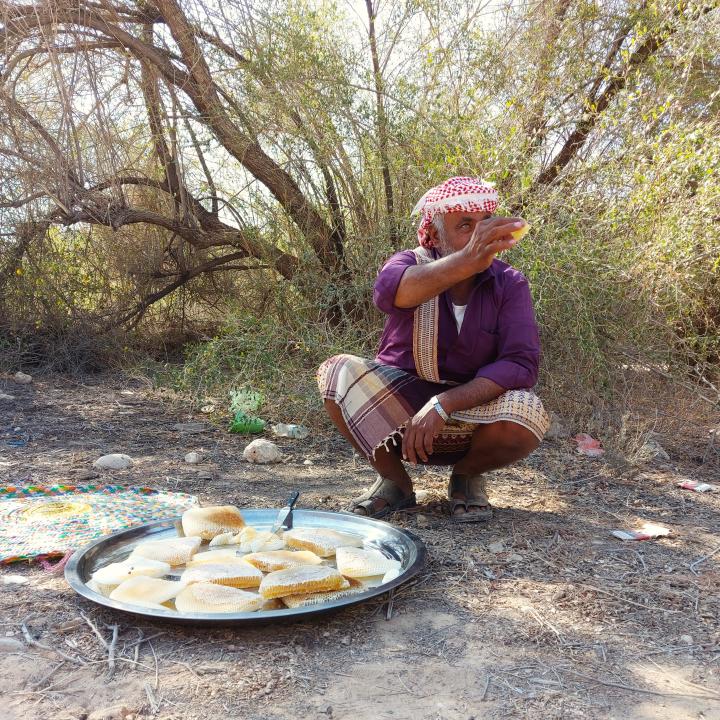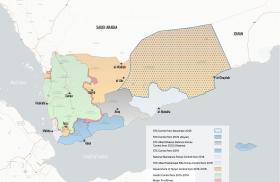
- Policy Analysis
- Fikra Forum
Yemeni Honey Production: An Ancient Craft Drawing Modern Attention

There is no question that promoting economic growth and improving the ability of Yemenis to make a living is one approach to breaking the cycle of poverty and violence in the country, but progress should also be tied to Yemeni culture and to environmental challenges to make it more sustainable.
Every November, beekeepers gather in Hadramawt governorate, southeast Yemen, to harvest Sidr honey, continuing a craft that their ancestors have practiced since at least the tenth century BC, which is now suffering under the weight of war, environmental degradation, and unsustainable harvesting practices. In light of unpredictable domestic and global conditions, sustainability is essential.
November marks the beginning of the late harvest season for Sidr honey in Hadramawt, which begins in September in other governorates, such as Amran and Saada. Honey harvesting seasons have remained the same for millennia, but the war in Yemen that has been going on since 2014 has made this craft difficult and dangerous.
Sidr is the finest and most expensive type of Yemeni honey, and Hadramawt governorate is the main producer of various types of honey in the country. The honey business in Yemen is believed to be worth $500 million a year, and the bee industry employs over 100,000 beekeepers. Yemen’s honey production increased from 679,000 tons in 2002 to 2,614,000 tons in 2013, but is now predicted to be barely 1,500 tons for 2023. Given the dire economic situation in Yemen, more individuals are entering the beekeeping sector in attempt to make ends meet. With the influx of new beekeepers, available land is both scarce and less productive. Additional pressures from the ongoing conflict and climate change further endanger the beekeeping sector, a practice once considered the pride of the country.
The stories of Yemen’s beekeepers sheds light on the dire situation of the craft. Beekeeper Saeed Knaid returned from Saudi Arabia to his homeland of Wadi Al-Ain in Hadramawt, preferring beekeeping to emigration. Ahmed bin Bakr, also from Wadi Al-Ain, has been beekeeping for fifty years and considers it not only an occupation, but a legacy from his parents that holds early memories for him. I met Saeed and Ahmed this season when they were harvesting honey in a wide palm field in Wadi Al-Ain, and what struck me is the magnitude of the problems they are facing and how the conflict unsustainable conditions truly threaten a career that is part of Yemenis’ identity and cultural legacy.
When a community’s cultural heritage is threatened, not only does it suffer from declining economic development and harm to people’s livelihoods; it also becomes more vulnerable to social disintegration and conflict, the last thing Yemenis want after more than a decade of insecurity. When a community loses its sense of identity, it risks alienating and even marginalizing diverse elements, leaving individuals or even the entire community adrift. This can happen when a community stops practicing skills and using knowledge from its ancestors, which give it a sense of pride and belonging.
Yemenis have historically relied on honey as a primary meal. It is used for breakfast, especially in the winter, as a nourishing diet for women, especially after childbirth, and as a sweetener and vital component in many Yemeni dishes. It is also a popular cure for many ailments. Bin Bakr points out that according to his experience and the experience of others, bee stings also have therapeutic benefits and can alleviate knee pain. The Holy Quran, a crucial source for many of Yemen’s long-established customs, strengthens trust in honey as a food and as medicine. Furthermore, scientific evidence supports the benefits of honey in the treatment of digestive problems, as well as its anti-depressant, anti-seizure, and anti-anxiety properties.
According to bin Bakr and others, until recently, because of the enormous amount of honey produced in Yemen, beekeepers would present large amounts of it to neighbors and loved ones during harvest seasons, which undoubtedly played an important role in social cohesion. Furthermore, beekeeping was not done for profit, but rather as a pastime or to provide food for the family. Because of Yemen’s economic decline, however, making a profit has become a key goal, yet beekeepers cannot produce enough now to do so. This change may expose beekeeping to the risk of excessive commercialization and sever its connection to Yemen’s cultural heritage and its role in bringing people together around a common goal, a common history, and established social relationships.
Bin Bakr states that unemployment encourages young people to pursue beekeeping as a source of income, an observation with which many agree and which is reinforced by other examples. While the work that beekeeping provides is unquestionably beneficial, there is a risk that honey production will become unsustainable. The increasing demand for beekeeping as a source of income, the loss of natural cover in Yemen, extreme weather events, and high costs not only make beekeeping a dangerous craft, but even threaten its extinction.
Yemen is losing vegetative cover at a rate that is too fast to allow it to compensate, both because of the growing need for firewood as an alternative cooking fuel and because of overgrazing. Yemen is believed to have destroyed more than six million trees since the conflict began in 2014. Bees rely on flower nectar to generate honey, and when flora declines and the number of beekeepers rises, the bees fight for a dwindling number of trees and are unable to produce enough honey. To address increased demand for work in beekeeping and increased demand for honey production, a larger number of trees should be planted.
Climate change in Yemen is causing various extreme weather events such as torrential rains, floods, and even long periods of drought. Although a reasonable amount of rain causes bee pastures to blossom, the rising intensity and frequency of rain, particularly during honey harvest times, prevents bees from grazing and making honey. Sudden floods may also sweep away bee houses in valleys, exposing their owners to significant losses. Yemeni beekeepers move bees from one location to another in a quest for suitable pastures, but such travel becomes more expensive as gasoline costs rise, and it also become riskier in some regions due to minefields or proximity to fire lines.
There is no question that promoting economic growth and improving the ability of Yemenis to make a living is one approach to breaking the cycle of poverty and violence in the country, but progress should also be tied to Yemeni culture and to environmental challenges to make it more sustainable. This can be accomplished through a holistic approach that combines building the community's capacity to maintain live cultural heritage while also protecting the environment. Plans for these two areas include, but are not limited to, training practitioners–and the local community–in traditional practices in more efficient ways, passing on knowledge and skills associated with their living cultural heritage to younger generations, and raising awareness of its importance and social function. Furthermore, investments should be made in environmental protection to make it more sustainable, such as planting more trees that provide fertile pastures for bees, creating appropriate water catchments, and constructing dams and water barriers.
Local communities and practitioners, such as beekeepers, should always be heavily involved in the creation and implementation of such strategies. Interventions should aim not only to provide resources for the current generation using a top-down approach, but also to secure adequate resources for future generations through a bottom-up approach based on community participation in order to achieve more long-term and sustainable peace and stability.
Photo courtesy of the author


